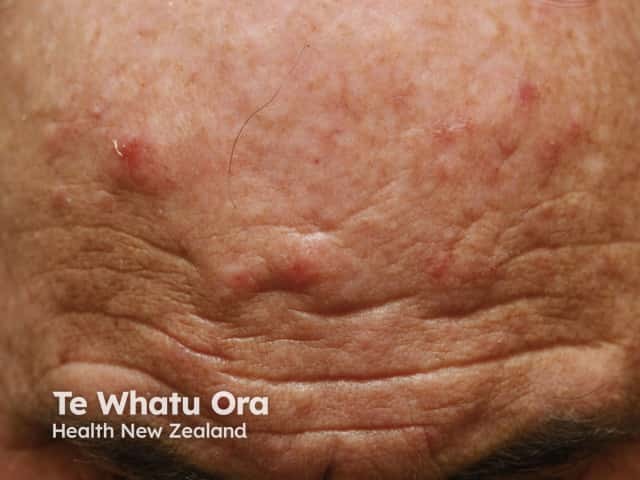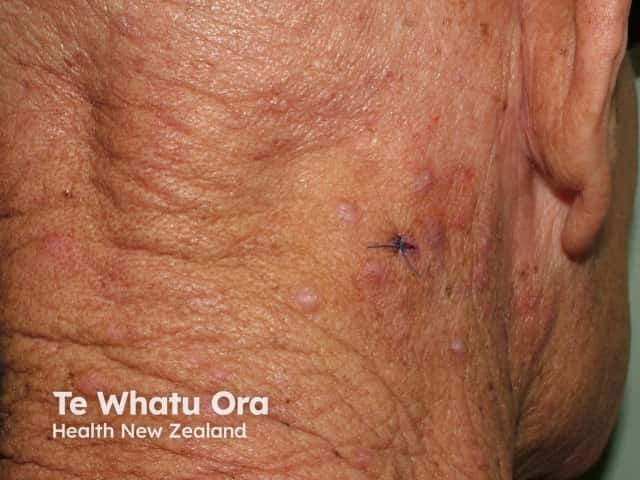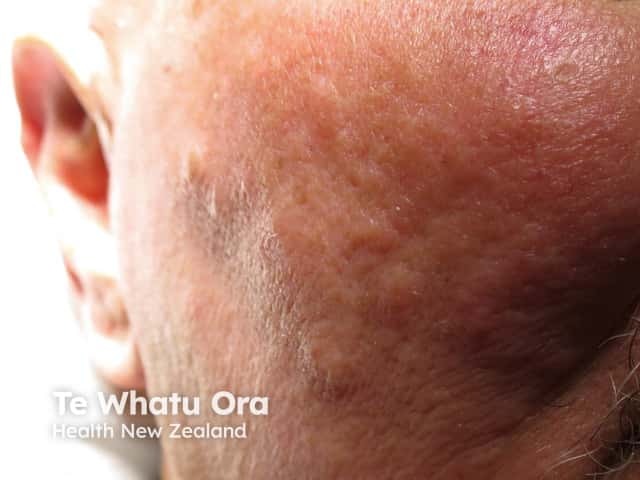Main menu
Common skin conditions

NEWS
Join DermNet PRO
Read more
Quick links
Eosinophilic dermatosis of haematological malignancy — extra information
Eosinophilic dermatosis of haematological malignancy
Author: Dr Peggy Chen, Dermatology Registrar, Middlemore Hospital, Auckland, New Zealand, July 2014.
Introduction Introduction - eosinophil Demographics Clinical features Causes Diagnosis Treatment
What is eosinophilic dermatosis of haematological malignancy?
Eosinophilic dermatosis of hematologic or haematological malignancy (blood cancer) is a rare skin eruption seen in patients with underlying haematological malignancy. It was first termed as exaggerated arthropod bite lesions, as the clinical and histological features resemble arthropod bites, with prominent eosinophilia (increased numbers of eosinophils).
What is an eosinophil?
An eosinophil is a type of white blood cell produced by bone marrow. It is characterised by coarse granules within the cell's cytoplasm. The functions of eosinophils include:
- Antiparasitic activity
- Bactericidal activity
- Modulation of inflammatory response
- Participation in allergic reactions.
Who gets eosinophilic dermatosis of haematological malignancy?
People with underlying haematological malignancies, in particular, chronic lymphocytic leukaemia (CLL). Less commonly, the condition has been documented in patients with acute myelocytic leukaemia, acute lymphocytic leukaemia, mantle cell lymphoma and multiple myeloma.
The skin eruption may happen at the same time, before, or after the diagnosis of the underlying haematological malignancy.
What are the clinical features of eosinophilic dermatosis of haematological malignancy?
The diagnosis of eosinophilic dermatosis of haematological malignancy is made by the following features:
- Recurring itchy or tender, small, dome-shaped bumps (papules) and lumps (nodules)
- Hives (urticarial weals)
- Variable sized, fluid-filled blisters (vesicles, and bullae)
- Involvement of exposed and non-exposed body sites.

Eosinophilic dermatosis of haematological malignancy

Eosinophilic dermatosis of haematological malignancy

Eosinophilic dermatosis of haematological malignancy

Eosinophilic dermatosis of haematological malignancy
What causes eosinophilic dermatosis of haematological malignancy?
The exact cause of eosinophilic dermatosis of haematological malignancy is poorly understood. One proposed theory is that the underlying cancer causes immune dysregulation. This leads to an imbalance in the production of cytokines (messenger proteins), with an increased production of interleukin-5 (IL-5). IL-5 recruits eosinophils into the skin.
How is the diagnosis made?
The diagnosis of eosinophlic dermatosis of haematological malignancy is based on the following diagnostic criteria:
- Itchy papules, nodules and/or vesiculobullous eruption
- No discernable relationship with outdoor activity
- On biopsy, eosinophil-rich lymphohistiocytic infiltrate in superficial and deep dermis with or without flame figures (these are extracellular eosinophil granules that coat collagen fibres in the dermis)
- Exclusion of other causes of tissue eosinophilia (such as drug reaction, insect bite reaction, eosinophilic folliculitis, and Wells syndrome)
- Preexisting diagnosis of a haematologic malignancy or its subsequent development.
What is the treatment for eosinophilic dermatosis of haematological malignancy?
A variety of treatments have been used to treat eosinophilic dermatosis of haematological malignancy, but they have been reported to be largely disappointing. They include:
- Topical and systemic corticosteroids
- Phototherapy
- Antihistamines
- Dapsone
- Interferon-alpha
- Intravenous immunoglobulin (IVIg)
- Chemotherapy.
It remains unclear whether eosinophilic dermatosis of haematologic malignancy may have prognostic implication. Some studies have suggested that patients with eosinophilic dermatosis of haematological malignancy do poorly compared to those patients with same haematological malignancy but without the skin condition.
References
- Qiao J, Sun CE, Zhu W, Zhu D, Fang H. Flame figures associated with eosinophilic dermatosis of hematologic malignancy: is it possible to distinguish the condition from eosinophilic cellulitis in patients with haematoproliferative disease? Int J Clin Exp Pathol. 2013 Jul 15;6(8):1683–7. Print 2013. PubMed PMID: 23923089; PubMed Central PMCID: PMC3726987.
- Farber MJ, La Forgia S, Sahu J, Lee JB. Eosinophilic dermatosis of hematologic malignancy. J Cutan Pathol. 2012 Jul;39(7):690–5. doi: 10.1111/j.1600-0560.2012.01906.x. Epub 2012 May 22. PubMed PMID: 22612903.
- Weed RI. Exaggerated delayed hypersensitivity to mosquito bites in chronic lymphocytic leukaemia. Blood.1965;26:257–68. PubMed
On DermNet
- Leukaemia cutis
- Urticaria-like disorders
- Paraneoplastic pruritus (cancer itch)
